Complete Solutions to CRITICALTHINKING of chapter RAY OPTICS of Class 11 book with complete answers and questions
| Class 11 | PHYSICS |
| Chapter | RAY OPTICS |
| TARGET PUBLICATION | CRITICALTHINKING |
| Number Of Questions | 38 |
| Academic Year | 2023-24 |
A concave mirror is placed on a horizontal table, with its axis directed vertically upwards. Let O be the pole of the mirror and C its centre of curvature. A point object is placed at C. It has a real image, also located at C. If the mirror is now filled with water, the image will be.
View SolutionIn case of reflection from curved surface
View SolutionA boy and lamb post are 80 m away from a concave mirror of focal length 20 cm. the boyd walks 40 m towrds the mirror. The boy will see
View SolutionA person standing 12 cm away from mirror A of focal length 10 cm see his image inverted and enlarged. When the mirror A is replaced by mirror B of same focal length the person observes diminished and erect image. Mirrors A and B are respectively.
View SolutionA plane mirror reflecting a ray of incident light is rotated through an angle q about an axis through the point of incidence in the plane of the mirror perpendicular to the plane of incidence, then
(1) The reflected ray rotates through an angle 2q
(2) The incident ray is fixed
(3) The reflected ray does not rotate
(4) The reflected ray rotates through an angle q
View SolutionIn a concave mirror experiment, an object is placed at a distance `x_(1)` from the focus and the image is formed at a distance `x_(2)` from the focus. The focus length of the mirror would be
View SolutionAs the position of an object (u) reflected from a concave mirror is varied, the position of the image (v) also varies. By latting the u changes from 0 to `+ oo` the graph between v versus u will be
View SolutionAssertion `:` A double convex lens `(mu=1.5)` has focal length `10 cm`. When the lens is immersed in water `(mu=4//3)` its focal length becomes `40 cm`.
Reason `:` `(1)/(f)=(mu_(1)-mu_(m))/(mu_(m))((1)/(R_(1))-(1)/(R_(2)))`
View SolutionA student measures the focal length of a convex lens by putting an object pin at a distance `u` from the lens and measuring the distance `v` of the image pin. The graph between `u` and `v` plotted by the student should look like
View SolutionThe ray diagram could be correct
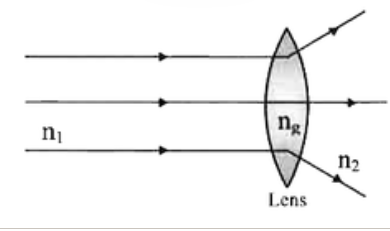
View SolutionHow does the magnification (m) of the real image formed by a lens vary with the distance (x) of the object from the focus of a concave mirror ?
View SolutionAn object is placed at a distance of `f//2` from a convex lens. The image will be
View SolutionThe power of a thin convex lens `(""_(a) mu_(g)=1.5)` is `+5.0 D`. When it is placed in liquid of refractive index `""_(a) mu_(l)` then it behaves as a concavelens of focal length 100 cm. the refractive index of liquid `""_(a) mu_(i)` will be
View SolutionFigure given below shows a beam of light converging at point P. When a concave lens of focal length 16 cm is introduced in the path of the beam at a placve O shown by dotted line such thatOP becomes the axis of the lens, the beam converges at a distance x from the lens. the value x will be equal to
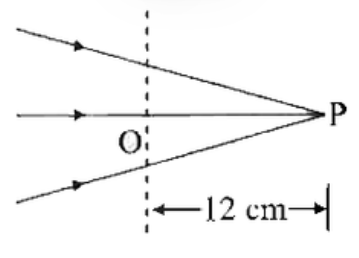
View SolutionA screen is placed 90 cm from an object. The image an object on the screen is formed by a convex lens two different locations separated by 20 cm. the focus length of the lense is
View SolutionWhen two thin lenses are kept in contanct, the focal length of the combination is
View SolutionAs shown in the figure, the liquids `L_1, L_2 and L_3` have refractive indices 1.55, 1.50 and 1.20 respectively. Therefore, the arrangement corresonds to
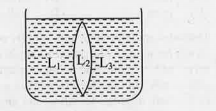
View SolutionWhen two or more lnses of magnification `m_(1) ,m_(2), m_(3)` are kept in contact, the total magnification (m) produced is given by
View SolutionA concave lens and a convex lens have same focal length of `20 cm` and both put in contact this combination is used to view an object `5 cm` long kept at `20 cm` from the lens combination. As compared to object the image will be
View SolutionIf we need a magnification of 400 from compound microscope of tube length 150 mm and an objective of focal length 5 mm, the focal length of the eye-piece, should be dose to : (final Image is at infinity).
View SolutionWhen objects at different distances are seen by the eye, which of the following remai constant?
View SolutionIf astronomical telescope of length `1.53m` has magnifying powerof magnitude 50,the values of `f_(0) and f_(e)` are
View SolutionWhen we view object of height 15 m with a telescop of magnifying power 10. the object appears _____
View SolutionThe focal length of the objective and eye piece of a telescope are respectively `100 cm and 2 cm`. The moon subtends and angle of `0.5^@`, the angle subtended by the moon's image will be.
View SolutionThe objective of telescope `A` has a diameter `3` times that of the objective of telescope `B`. How much greater amount of light is gathered by `A` compared to `B` ? Show that range of `A` is three times the range of `B`.
View SolutionA fly is sitting on the objective of a telescop pointed to the moon takne through the elescope ?
View SolutionAn object is placed at a distance u from a concave mirror and its real image is formed on the screen placed at distance v from the mirror. If f is the focal length of the mirror, then the graph between `frac(1)(v) versus frac(1)(u)` is (magnitude only)
View SolutionThe distance between an object and the screen is 75 cm. When a convex lens of focal length 12 cm is placed in the between theobject and the screen, magnification of real formed can be (magnitude only)
View SolutionTwo similar planoconvex lenses are combined together in three different ways as shown in the adjoining figure. The ratio of the focal lengths in three cases will be
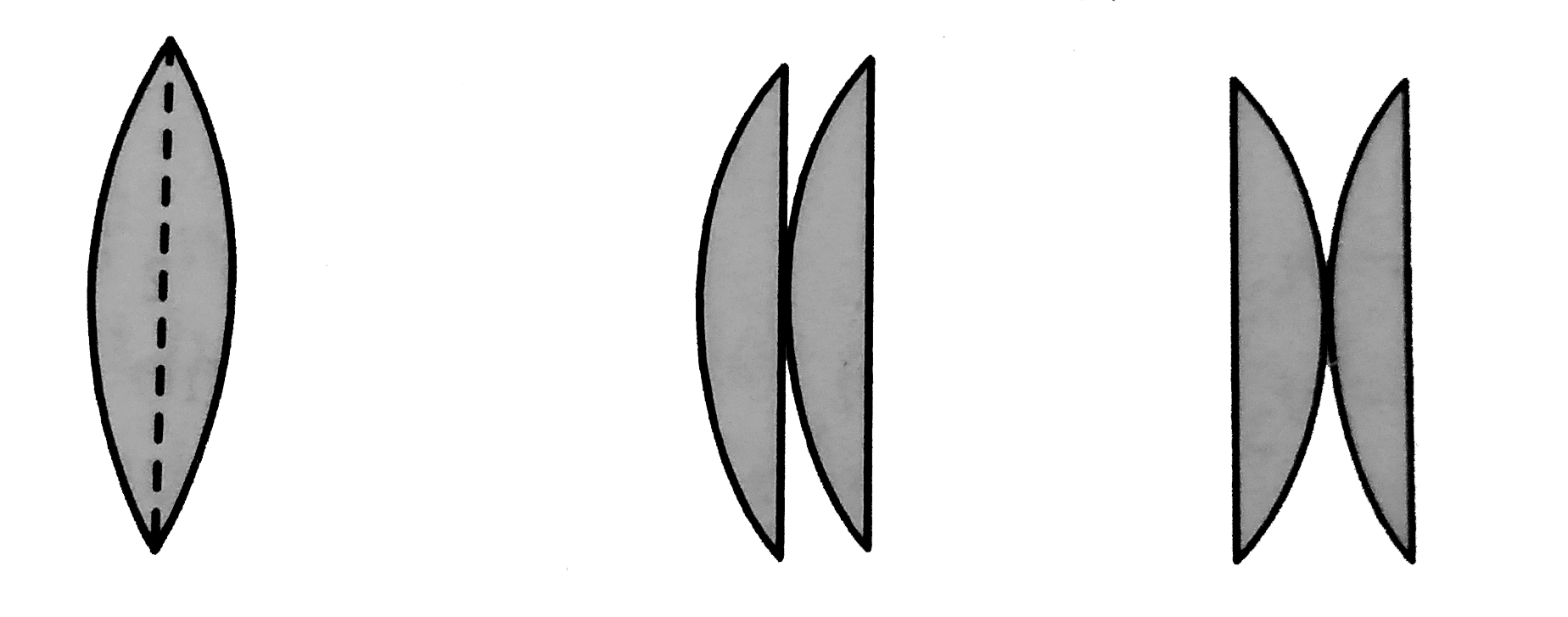
View SolutionA virtual cannot be caought on a screen, Yet when we see a virtual image, we bring it to the screen i.e., retina of our eye. This happnes because
View SolutionWhen the wavelenght of the light used is increased, the focal length of a spherical mirror
View SolutionIf two power of a thick lense is `P_(1)` and that of a thin lens is `P_(2)` then
View SolutionHow will you arrange the two plane mirros so that whatever may be the angle of incidence, the incident ray and the reflected ray from the two mirrors will be paralle to each other ?
View SolutionAn object is placed in front of a convex mirror at a distance of 50cm. A plane mirror is introduced covering the lower half of the convex mirror. If the distance between the object and the plane mirror is 30cm, it is found that there is no parallax between the images formed by the two mirrors. What is the radius of curvature of the convex mirror?
View SolutionA square wire of side `3.0 cm` is placed `25 cm` away from a concave mirror of focal length `10 cm`. What is the area enclosed by the image of the wire ? The centre of the wire is on the axis of the mirror, with its two sides normal to the axis.
View SolutionThe lens shown in the figure drawn below is made of two different materials. A point object is placed on the axis. The number of images formed is ___________.
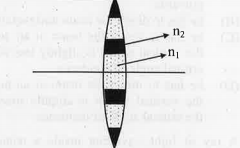
View SolutionIf a lens is cut into two pieces perpendicular to the principal axis and only one part is used, the intensity of the iamage will be
View SolutionAssertion : A concave mirror and convex lens both have the same focal length in air. When they are submerged in water, they will have same focal length.
Reason refractive index of water is smaller than be refractive index of air.
View Solution
CRITICALTHINKING questions and complete solutions for chapter RAY OPTICS of TARGET PHYSICS (MARATHI ENGLISH) of Class 11